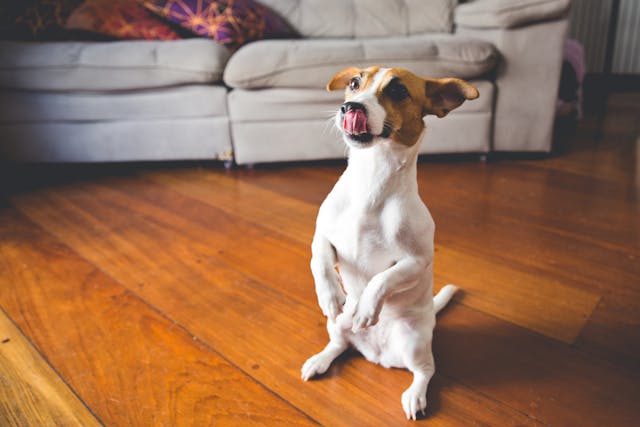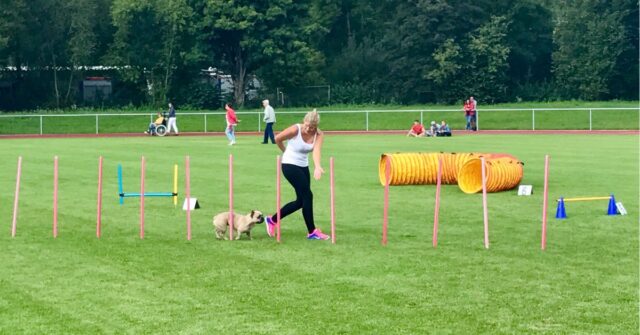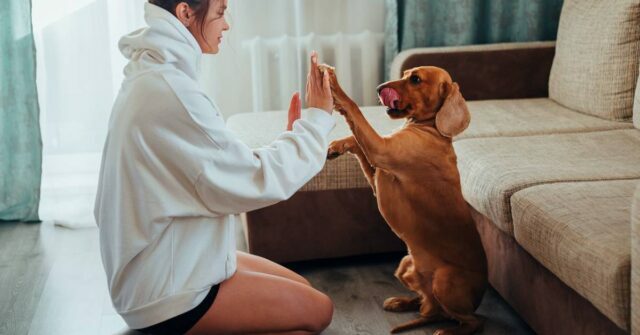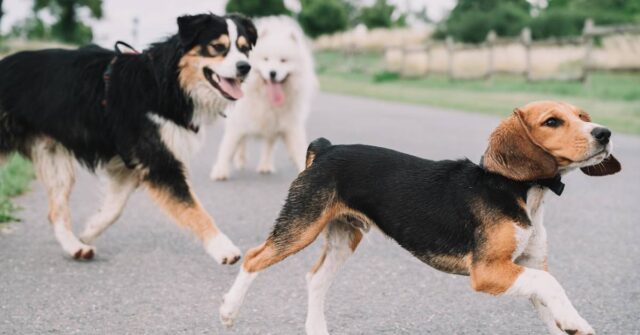To foster a deeper connection with your canine companion, it’s essential to grasp the nuances of their body language. Dogs, unlike humans, rely heavily on visual signals to communicate.
By decoding these signals, you can better understand their needs, emotions, and intentions, paving the way for a more harmonious relationship.
Introduction to Canine Communication
Dogs communicate with us primarily through body language. They don’t use words but instead rely on a complex system of visual signals to express their emotions and intentions.
Understanding these signals is crucial for dog owners to ensure their pets’ well-being and foster a strong bond.
Just as we might misinterpret a friend’s tone over text, misunderstanding a dog’s body language can lead to confusion and stress for both the pet and the owner.

The Importance of Observing Body Language
Observing your dog’s body language can reveal a lot about their emotional state. Are they relaxed, anxious, or excited?
These signals can help you provide better care, avoid potential conflicts, and enhance your relationship with your dog.
For example, recognizing the signs of stress can prevent situations that might lead to aggression or fear.
How Dogs Communicate: More Than Just Barks
While barking is a vocal signal, most of a dog’s communication is non-verbal. Dogs use their entire body to convey messages.
Their ears, tail, eyes, and overall posture work together to provide a comprehensive picture of how they feel.
By paying close attention to these cues, you can better understand what your dog is trying to tell you.
Decoding Basic Dog Body Signals
Transitioning from the basics of canine communication, we delve into the specifics of how dogs express their emotions and intentions through their body language.
Each gesture and posture carries a wealth of information that, when understood, can significantly enhance the interaction between you and your dog.
Facial Expressions: From Eyes to Mouth
Facial expressions are a key component of dog body language. A relaxed, open mouth with a slightly lolling tongue often indicates happiness.
Conversely, a closed mouth with tense lips can signal discomfort or aggression. The eyes are also very telling. Soft, squinting eyes suggest a calm dog, while wide, darting eyes might indicate fear or stress.
Ears and Their Positions
Ears can be very expressive. Erect ears often mean the dog is alert and interested, while ears laid back against the head usually signal fear or submission.
Some breeds have naturally floppy ears, so it’s important to understand what is normal for your dog and look for changes in their typical ear positions.

The Tale of Tails: Wagging, Tucking, and More
Tail movements can be complex. A wagging tail doesn’t always mean a happy dog. The speed and direction of the wag can indicate different emotions.
A slow wag might mean the dog is feeling cautious, while a high, stiff wag can be a sign of alertness or aggression. A tail tucked between the legs generally signifies fear or submission.
Understanding Postures and Movements
Having explored the fundamental signals through facial expressions and ear positioning, we now examine the broader aspects of posture and movement.
These behaviours provide deeper insights into a dog’s emotional state and intentions, offering clues that are vital for effective communication.
Reading Posture: Relaxed, Tense, and Everything in Between
A dog’s posture can tell you a lot about how they’re feeling. A relaxed dog will have a loose, comfortable stance, while a tense dog may appear rigid or stiff.
Watching how your dog moves can also provide clues. For instance, a dog that backs away slowly is likely feeling cautious or fearful.
Significance of Movement: Leaning, Rolling, and Freezing
Movements such as leaning forward or backward can indicate a dog’s intentions. Leaning forward often shows interest or aggression, while leaning back can signal uncertainty or submission.
Rolling onto their back might be a sign of trust and submission, but it can also be a defensive posture if the dog feels threatened.
Freezing in place is usually a sign of extreme fear or stress, often preceding a more overt reaction like growling or biting.

Signs of Emotions in Dogs
Recognizing specific emotions in dogs is key to responding appropriately to their needs.
This section covers how to identify various emotional states through observable behaviours, helping owners make more informed decisions that contribute to a dog’s overall well-being.
Recognizing Happiness and Contentment
Happy dogs often have a relaxed posture, wagging tails, and open, smiling mouths. They might also exhibit playful behaviours like bowing, where the front end lowers while the back end stays up.
These signals show that your dog is comfortable and enjoying themselves.
Identifying Signs of Stress and Anxiety
Signs of stress in dogs include yawning, lip licking, and avoiding eye contact.
They might also show displacement behaviours like scratching or sniffing the ground in situations where these actions don’t make sense.
Recognizing these signs early can help you address the source of stress before it escalates.
Signals of Aggression and Fear
Aggressive body language includes a stiff posture, raised hackles, and a direct stare. Growling, baring teeth, and lunging are more obvious signs.
Fearful dogs might cower, tuck their tails, and try to hide. Understanding these signals can help prevent bites and other aggressive incidents.

Interpreting Complex Behaviors
Dogs often display more nuanced behaviours that can be confusing to interpret.
This section breaks down these complex behaviours into understandable parts, focusing on calming signals, play behaviours, and stress indicators.
Calming Signals and What They Mean
Dogs use calming signals to diffuse tension and avoid conflict. These include yawning, turning their head away, and sitting down.
By recognizing these signals, you can help reduce your dog’s stress and promote a more relaxed environment.
Play Behaviors and Social Interactions
Play behaviours like bowing, jumping, and gentle mouthing are signs that your dog wants to have fun.
Play is an important part of a dog’s social development and helps them build bonds with both humans and other dogs.
Understanding these behaviours ensures you can provide appropriate playtime and socialization.
Displacement Behaviors: Stress Indicators
Displacement behaviours, such as scratching, licking, or excessive grooming, often occur when a dog is conflicted or stressed. These behaviours can be a way for dogs to self-soothe.
Monitoring these actions can help you identify and address the sources of your dog’s stress.

Practical Tips for Dog Owners
Equipped with an understanding of dog body language, owners can apply this knowledge practically.
This section provides actionable tips to help you respond effectively to your dog’s communication, enhancing safety and reinforcing positive interactions.
How to Respond to Your Dog’s Body Language
When you understand your dog’s body language, you can respond appropriately to their needs. If your dog shows signs of stress, give them space and a calm environment.
Reward relaxed and happy behaviours to reinforce those states.
Training Tips Using Body Language Cues
Training with body language involves observing and responding to your dog’s signals.
Positive reinforcement techniques, such as treats and praise, work best when timed with your dog’s natural behaviours. For example, rewarding your dog for sitting calmly can help reinforce that behaviour.
Safety Measures: Preventing Dog Bites
Preventing dog bites involves recognizing warning signs and giving your dog space when needed. Teach children and visitors how to interact with your dog safely.
Never force interactions, especially if your dog is showing signs of stress or aggression.

Real-Life Examples
Real-life examples can effectively illustrate how theoretical knowledge of dog body language applies in everyday situations.
These case studies demonstrate practical applications and outcomes of interpreting and responding to dogs’ body signals.
Case Study: Recognizing Stress Before a Vet Visit
One owner noticed their dog yawning and licking its lips excessively before a vet visit.
Recognizing these signs of stress, they spent extra time calming their dog with gentle patting and soft words, which made the visit smoother and less traumatic.
Case Study: Interpreting Play at the Dog Park
At the dog park, one dog owner noticed their pet bowing and wagging its tail energetically.
Understanding these were play signals, they allowed their dog to interact freely with others, resulting in a fun and positive social experience.
Conclusion
As we wrap up this comprehensive guide, it’s important to reflect on the myriad ways in which dogs communicate.
By becoming adept at reading their body language, you not only enhance your bond but also contribute to their overall happiness and well-being.
This understanding is a cornerstone of responsible dog ownership and a fulfilling relationship with your furry friend.

Summary of Key Points
Understanding your dog’s body language is crucial for their well-being and your relationship.
From facial expressions to tail wags, every signal provides insight into their emotional state. Recognizing and responding to these signals can prevent stress and aggression, ensuring a happier, healthier pet.
Further Resources and Learning Tools
For more information, consider reading books on canine behaviour, attending dog training classes, or consulting with a professional dog behaviourist.
These resources can provide deeper insights and personalized advice to help you and your dog thrive together.











